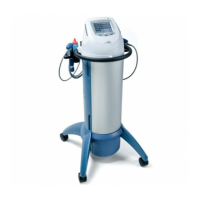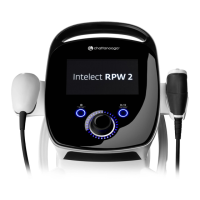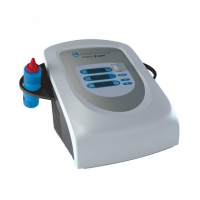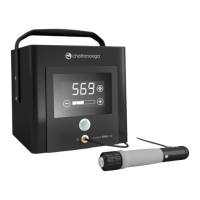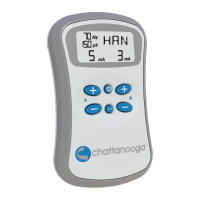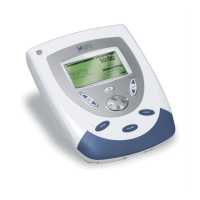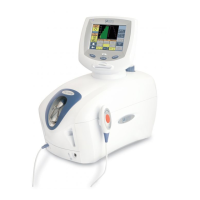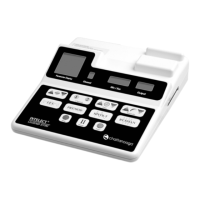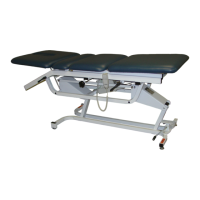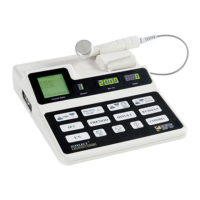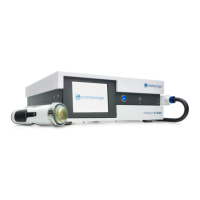What causes intermittent output on Chattanooga Revolution Wireless Medical Equipment?
- MMichael BarreraSep 9, 2025
Intermittent output may occur if an intermittent program is in use. This is expected behavior for some programs.
What causes intermittent output on Chattanooga Revolution Wireless Medical Equipment?
Intermittent output may occur if an intermittent program is in use. This is expected behavior for some programs.
What to do if Chattanooga Medical Equipment stimulation is uncomfortable?
If the stimulation is uncomfortable, it might be due to several factors. First, the amplitude (intensity) may be too high, so decrease it. Second, the electrodes might be too close together; reposition them to be a minimum of 2 inches apart. Also, check if the electrodes or module leadwires are damaged or worn and replace if needed. Ensure the proper program is being used.
How to fix Chattanooga Revolution Wireless electrode failure?
Electrode failure can occur due to a poor electrode connection to the modules. Check that the electrodes are properly connected to the module. Another cause can be a poor electrode connection to the skin, so check if the electrodes are outdated, worn, and/or the contact is poor; try with new electrodes.
What to do if Chattanooga Revolution Wireless Medical Equipment stimulation stops with charged batteries?
If the stimulation stops even with charged batteries, it could be due to poor electrode contact. Reapply the electrodes and secure them firmly, ensuring they are a minimum of 2 inches apart. Alternatively, the electrodes or module leadwires may be damaged or worn, in which case you should replace them.
Why is Chattanooga Revolution Wireless stimulation ineffective?
If the stimulation is ineffective, it might be due to improper electrode placement. Reposition the electrodes, ensuring they are a minimum of 2 inches apart.
How to resolve Chattanooga Medical Equipment weak stimulation with charged batteries?
If you're experiencing weak stimulation even with charged batteries, the electrodes may have dried out, lost their adhesive power, and no longer have adequate connection to the skin. Replace the electrodes. Also, ensure proper electrode placement, maintaining at least 2 inches of space between them.
How to troubleshoot Chattanooga Revolution Wireless remote control not charging?
If the remote control is not charging, check the connections to ensure the USB cable of the docking station is connected to the tablet and that the power cord of the tablet is connected to the mains.
What to do if the docking station’s central LED lights red on Chattanooga Medical Equipment?
If the docking station’s central LED lights red, it indicates that the modules can’t be charged due to no connection to the tablet or main power. Ensure that the modules are properly placed in their housing and that the charging contacts are clean. Also, ensure the correct AC adapter is used. Disconnect and reconnect the docking station and check the lighting sequence of the docking station upon activation.
How to resolve Chattanooga Revolution Wireless stimulation only felt on one electrode?
If stimulation is only felt on one electrode, it is likely due to improper electrode placement. Reposition the electrodes, ensuring they are a minimum of 2 inches apart. If the issue persists, replace the electrodes.
What to do if Chattanooga Revolution Wireless display does not come on?
If the display does not come on, it is likely due to low batteries. Charge the batteries.
Details on where and by whom the device is intended to be used.
Explains the goals and forms of therapy provided by the unit.
Lists conditions and uses for the device as NMES and TENS.
Details situations and patient conditions where the device must not be used.
Describes potential negative effects and additional safety precautions.
Explains symbols like Danger, Warning, Caution, etc., and their meanings.
Lists all items included in the kit and re-orderable parts.
Details symbols used on device parts and charging station.
Provides detailed descriptions of the Remote Control and Modules.
Explains the Smart 4CH docking station and removable tablet.
Illustrates and describes various display screens and modes.
Instructions for connecting the unit and performing performance checks.
Guides on how to charge the device's components.
Explains the process of synchronizing the remote control with modules.
Steps for selecting a program category and a specific program.
Details on how to enable or disable program options.
Information on electrode types and placement recommendations.
Guidance on optimal patient positioning for treatments.
Instructions for securely attaching modules to electrodes.
Steps to initiate a therapy session after module activation.
Procedures for stopping a therapy session.
Information on how the unit performs checks and handles issues.
Explains modes for manual triggering of muscle contraction.
Details on features like Favorite List, Lock Out, Synchronization, and Identify Modules.
Configuration options for backlight, buzzer, language, time, and system info.
Identifies display errors like poor electrode contact or module connection.
Explains LED status for module range, recognition, and battery level.
Troubleshooting for docking station LED indicators.
Addresses issues like device not responding or low battery.
Guidelines for cleaning and disinfecting the device and accessories.
Information on device calibration, testing, and user-serviceable parts.
Instructions for safely transporting the device and its components.
Information on disposal, recycling, and the device's expected lifespan.
Includes general information, stimulation parameters, and wireless descriptions.
Details the standards the device complies with (IEC, EMC).
Provides details on the product warranty and its coverage.
Mentions innovations with pending or issued patents.
Recommendations concerning electromagnetic emissions for the device.
Recommendations for electromagnetic immunity in specified environments.
Guidance on spacing for portable and mobile communication devices.
Details on where and by whom the device is intended to be used.
Explains the goals and forms of therapy provided by the unit.
Lists conditions and uses for the device as NMES and TENS.
Details situations and patient conditions where the device must not be used.
Describes potential negative effects and additional safety precautions.
Explains symbols like Danger, Warning, Caution, etc., and their meanings.
Lists all items included in the kit and re-orderable parts.
Details symbols used on device parts and charging station.
Provides detailed descriptions of the Remote Control and Modules.
Explains the Smart 4CH docking station and removable tablet.
Illustrates and describes various display screens and modes.
Instructions for connecting the unit and performing performance checks.
Guides on how to charge the device's components.
Explains the process of synchronizing the remote control with modules.
Steps for selecting a program category and a specific program.
Details on how to enable or disable program options.
Information on electrode types and placement recommendations.
Guidance on optimal patient positioning for treatments.
Instructions for securely attaching modules to electrodes.
Steps to initiate a therapy session after module activation.
Procedures for stopping a therapy session.
Information on how the unit performs checks and handles issues.
Explains modes for manual triggering of muscle contraction.
Details on features like Favorite List, Lock Out, Synchronization, and Identify Modules.
Configuration options for backlight, buzzer, language, time, and system info.
Identifies display errors like poor electrode contact or module connection.
Explains LED status for module range, recognition, and battery level.
Troubleshooting for docking station LED indicators.
Addresses issues like device not responding or low battery.
Guidelines for cleaning and disinfecting the device and accessories.
Information on device calibration, testing, and user-serviceable parts.
Instructions for safely transporting the device and its components.
Information on disposal, recycling, and the device's expected lifespan.
Includes general information, stimulation parameters, and wireless descriptions.
Details the standards the device complies with (IEC, EMC).
Provides details on the product warranty and its coverage.
Mentions innovations with pending or issued patents.
Recommendations concerning electromagnetic emissions for the device.
Recommendations for electromagnetic immunity in specified environments.
Guidance on spacing for portable and mobile communication devices.
| Category | Medical Equipment |
|---|---|
| Wireless Technology | Bluetooth |
| Channels | 2 |
| Pulse Width | 50-400 μs |
| Battery | Rechargeable Lithium-ion |
| Wireless Range | Up to 10 meters |
| Power Output | 0-100 mA |
| Amplitude | 0-100 mA |
| Intensity Levels | Adjustable |
| Modes | Continuous, Burst |
| Programs | Pre-set and Customizable |
| Display | LCD |
| Power Source | Battery |
| Compatibility | Android and iOS devices |
